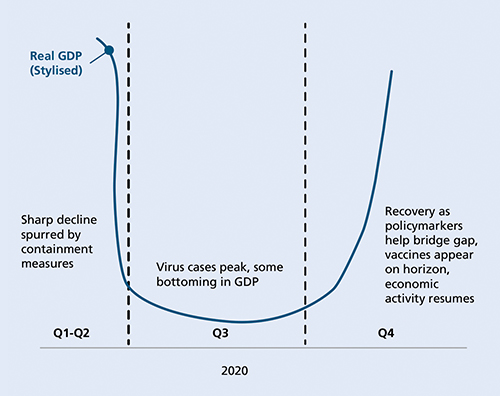From hurting to healing

|
Written By: Joachim Fels |
Joachim Fels of PIMCO expects the global economy and financial markets to transition from intense near-term pain to gradual healing over the next six to 12 months. Warning however, that there is a risk of an uneven recovery, with significant setbacks along the way and some permanent damage
Following the longest expansion on record, the coronavirus pandemic has plunged the global economy into what could be one of the deepest but also shortest recessions in modern times. However, any outlook now is more uncertain than usual. Unlike previous recessions, usually caused by the interplay of economic and financial imbalances, interest rate hikes, or oil price spikes, the trigger of the present crisis is an exogenous shock. The severity of the Covid-19 health crisis has led governments around the world to lock down populations and aggressively curtail economic and social activity, causing a sharp drop in aggregate output and demand. We are seeing the first-ever recession by government decree – a necessary, temporary, partial shutdown of the economy aimed at preventing an even larger humanitarian crisis.
Economic policy response
What is also different this time is the unprecedented speed and size of the monetary and fiscal response, as policymakers and monetary authorities try to prevent a recession turning into a lasting depression.
Central banks have stepped up as lenders of last resort not only for banks, but also for other financial intermediaries and even nonfinancial companies. Their support has come via a range of lending and asset purchase programmes.
On the fiscal front, many governments have offered guarantees for bank loans to businesses, tax payment delays, backstops for central bank lending programs, direct income transfers to households, and subsidies for businesses. In many countries, the fiscal response already exceeds that during the 2008-2009 global financial crisis, and we may see further support in the near future.
The cyclical base case: from hurting to healing
Given the sheer size of support measures and the absence of major real economic imbalances, we expect the global economy to transition from intense near-term pain to gradual healing over the next six to 12 months, once the spread of the coronavirus is under control and restrictions are lifted.
However, our base case remains a U-shaped rather than a V-shaped recovery (see Figure 1) because these restrictions will likely be lifted only gradually and at different speeds in different sectors and regions. Also, repairing broken global supply chains will take time. As a consequence, following the nosedive in economic activity that is currently underway (the downward I in the U), we expect the bottoming process to last a few months after the virus is under control (the L in the U), before output and demand ramp back up, helped by fiscal and monetary support and the eventual easing of the acute health crisis.
Figure 1: Forecast of a U-shaped recovery in real global GDP, but there is much uncertainty around this baseline

Source: PIMCO. For illustrative purposes only.
The risks: longer stagnation, or recovery and relapse
The base case forecast, however, could be challenged if the pandemic lasts longer than expected, or if there is an increase in corporate defaults above expectations. We see two downside risk scenarios: a prolonged L-shaped trajectory or a recovery interrupted by a relapse – call it a W.
A V-shaped recovery is in theory possible, but it’s a remote upside risk, in our view. Such a trajectory could be the result of successful macroeconomic policy, medical breakthroughs, and an increase in the capacity of health systems and governments to deal with the current crisis.
A glimpse into the post-Covid world
We believe this crisis is likely to leave three long-term scars:
Globalisation may be dialled back: Firms may try to reduce the complexity and risk of global supply chains, and governments may use health concerns to curb trade, travel, and migration. Companies, sectors, and countries that are highly dependent on trade and travel may see a lasting hit to their business models.
More private and public debt: This could challenge central bank independence as central banks become more involved in providing support to companies (essentially a fiscal act), and also keep rates low to help finance deeper fiscal deficits. If governments continue their fiscal expansions even after the crisis, the dominance of fiscal over monetary policy may lead to higher inflation than markets currently price in. But with central banks capping the rise in nominal yields that would normally result from higher inflation, real rates would tend to fall as inflation rises.
Shift in household saving behavior: Rising unemployment and higher levels of personal debt may make households more cautious, lifting demand for low-risk assets such as bonds and cash. In addition, homeowners may be keen to pay down their mortgages faster. Thus, with the private sector saving glut likely to rise further, investors should brace themselves for a New Neutral 2.0 of even more depressed real interest rates over the secular horizon.
Investment implications: caution first
Investors should brace themselves for a very different investment landscape as the weakest areas in the global credit spectrum will be exposed over the next several months. While this should create more attractive entry points in higher-risk segments of the investment universe over time, we remain patient and focus on opportunities that we see as high quality, default-remote assets for now. We believe a caution-first approach is warranted in an effort to protect against permanent capital impairment.
In our view, this approach includes a focus on US duration; despite significant relative outperformance, we still see room for US rates to drop further if stabilisation takes longer than our baseline outlook. We see US agency mortgage-backed securities (MBS) and US Treasury Inflation-Protected Securities (TIPS) as attractive high quality assets despite recent volatility.
We have for some time been cautious on corporate credit, due in part to valuation and market functioning issues, but we now see some opportunity to add long-dated, high quality exposures that we believe compensate for the risk taken. In private credit, we anticipate opportunity to seek attractive liquidity premiums. We remain cautious on the weaker segments of the investment grade, high yield, and loan markets.
We will take a cautious approach on European sovereign debt and will continue to watch closely any monetary and fiscal action. Emerging markets (EM) are heading into this recession with few major macro imbalances, but also limited monetary and fiscal capacity. This, plus a persistent negative shock to oil prices, suggests taking a cautious approach to EM while also assessing select opportunities.
For investment professionals only. PIMCO Europe Ltd (Company No. 2604517) Ltd (Company No. 2604517) and PIMCO Europe Ltd – Italy (Company No. 07533910969) are authorised and regulated by the Financial Conduct Authority (12 Endeavour Square, London E20 1JN) in the UK. PIMCO Europe Ltd services are available only to professional clients as defined in the Financial Conduct Authority’s Handbook and are not available to individual investors, who should not rely on this communication.
More Related Content...
|
|
|